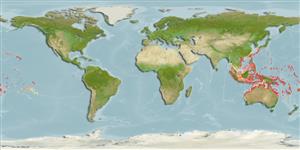>
Eupercaria/misc (Various families in series Eupercaria) >
Labridae (Wrasses) > Corinae
Etymology: Halichoeres: Greek, als, alis = salt + Greek, choiros = pig (Ref. 45335).
More on authors: Quoy & Gaimard.
Environment: milieu / climate zone / kisaran kedalaman / distribution range
Ekologi
laut berasosiasi dengan karang; kisaran kedalaman 2 - 30 m (Ref. 48636), usually 2 - 18 m (Ref. 89972). Tropical; 30°N - 32°S
Indo-Pacific: Christmas Island and Rowly Shoals in the eastern Indian Ocean to the Line and Ducie islands, north to south Japan, south to Lord Howe Island.
Size / Weight / umur
Kematangan: Lm ? range ? - ? cm
Max length : 27.0 cm TL jantan/; (Ref. 9710)
deskripsi pendek
Kunci identifiaksi (pengenalan) | Morfologi | Morfometrik
Duri punggung (Keseluruhan (total)) : 9; duri punggung lunak (Keseluruhan (total)) : 11; Duri dubur: 3; Sirip dubur lunak: 10 - 11. Light greenish to yellowish on back, white below; scale rims pink to blackish; a black spot is at the upper base of the pectoral fin; another black spot about equal to eye diameter is at the upper base of the caudal peduncle.
Body shape (shape guide): fusiform / normal; Cross section: compressed.
Inhabits sandy areas of reef flats, lagoons, and semi-protected seaward reefs. Juveniles shallow in protected coastal waters; adults to about 30 m depth (Ref. 48636). Feeds on sand and rubble dwelling invertebrates (crustaceans, mollusks, forams, polychaetes, fish eggs, and small fishes). Has the habit of following sand-disturbing fishes such as goatfishes in order to intercept escaping prey. Minimum depth reported taken from Ref. 30874.
Life cycle and mating behavior
Kematangan | Reproduksi, perkembang biakan | Pemijahan | telur-telur | Fecundity | Larva
Bi-directional sex change has been confirmed for this species (Ref. 103751). Distinct pairing during breeding (Ref. 205).
Randall, J.E., G.R. Allen and R.C. Steene, 1990. Fishes of the Great Barrier Reef and Coral Sea. University of Hawaii Press, Honolulu, Hawaii. 506 p. (Ref. 2334)
Status IUCN Red List (Ref. 130435: Version 2025-1)
ancaman kepada manusia
Harmless
penggunaan manusia
Perikanan: komersial; Akuarium: Komersial
Alat, peralatan
laporan khas
muat turun XML
Sumber internet
Estimates based on models
Preferred temperature (Acuan
123201): 24.7 - 29.3, mean 28.4 °C (based on 2136 cells).
Phylogenetic diversity index (Acuan
82804): PD
50 = 0.5000 [Uniqueness, from 0.5 = low to 2.0 = high].
Bayesian length-weight: a=0.01023 (0.00637 - 0.01644), b=2.99 (2.86 - 3.12), in cm total length, based on LWR estimates for this species & Genus-body shape (Ref.
93245).
Trophic level (Acuan
69278): 3.5 ±0.51 se; based on food items.
Daya lenting (Acuan
120179): sedang, Waktu penggandaan populasi minimum 1.4 - 4.4 tahun (Preliminary K or Fecundity.).
Fishing Vulnerability (Ref.
59153): Low vulnerability (17 of 100).
🛈
Nutrients (Ref.
124155): Calcium = 57.9 [35.4, 92.7] mg/100g; Iron = 0.608 [0.360, 1.098] mg/100g; Protein = 18.6 [15.7, 20.7] %; Omega3 = 0.141 [0.095, 0.211] g/100g; Selenium = 25.8 [16.3, 44.2] μg/100g; VitaminA = 119 [38, 421] μg/100g; Zinc = 1.45 [1.04, 2.25] mg/100g (wet weight);
